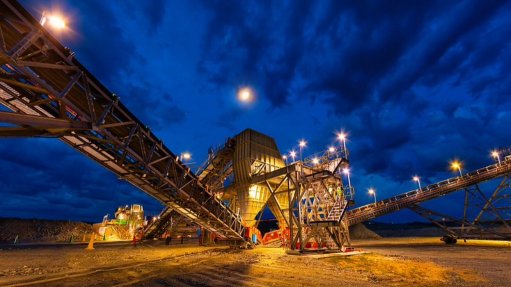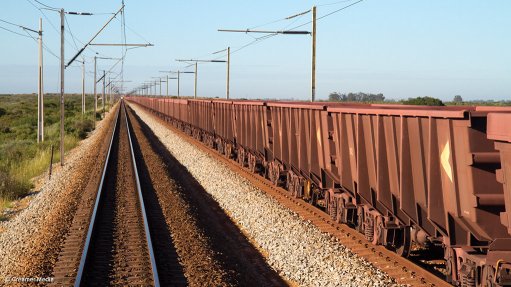Accessing the growth potential of tailings retreatment and rehabilitation
New research, developments in technology and advancements in equipment are unlocking significant growth opportunities in the extraction and treatment of tailings in South Africa.
However, while there are many benefits in the development of the tailings sector, various risks remain, including the safety of communities surrounding tailings dams, ensuring efficient and cost-effective extraction, environmental factors and infrastructure management, besides others.
This emerged during a Creamer Media webinar, ‘Untapping the growth potential of tailings retreatment and rehabilitation’, held on April 10, which was facilitated by Stellenbosch University Department of Civil Engineering geotechnical associate Professor Charles MacRobert.
The panellists included DRDGOLD CEO Niël Pretorius, Southern African Institute of Mining and Metallurgy tailings committee member Dr Kym Morton, Weir Minerals tailings and backfill global manager Erik Vlot and Jones & Wagener environmental engineering department’s closure and rehabilitation team associate civil engineer Alice Harvey.
However, Pretorius pointed out that extensive volume throughput is required to ensure the economic viability of mining tailings, which has long been known for being a volume- and capital-intensive process.
“At one facility, we are processing [at a lower grade site] the better part of 500 000 t every month and we are retrieving or recovering about 30 kg of gold from that, so it gives you an indication of just what sort of throughput you have to maintain in order to have a financially viable model.”
Much consideration is required in terms of the size of the plant infrastructure, the amount of power and water used and the cost of reagents when expanding tailings production and it is difficult to keep increasing volume.
“It all adds up,” he said, adding, however, that: “We are fortunate in South Africa, [with] the footprint and operating density and size of the resource – and then adding 120-odd years of tailings accumulation on surface – I am not aware of many other opportunities like that globally where so much has been accumulated in such a small area.”
Further, recent research shows a positive outlook.
Pretorius cited new research which had found that, through incremental improvements in technologies to ensure extraction efficiency, lower grade materials could be mined, along with a “second generation” of tailings that have been created and stored centrally which could once again find its way through a plant, and thereby extend the life of the operations.
“The research that has been published is actually quite exciting because it is telling us is that we are not getting all of [the resource] . . . and that there might be some of it that we did not know about.”
“The research found technology to actually confirm its presence and to measure it to some sort of an extent to express an opinion as to how much more there could be. If it is there, obviously it is worthwhile to start looking at technologies to start mining it at scale.”
Meanwhile, new technologies, solutions and collaboration with the customer’s needs are enabling the more efficient extraction within operations and mine rehabilitation.
Vlot said that the substantial amount of equipment required in the sector provided Weir Minerals the opportunity to collaborate with clients, review how to improve the various solutions and solve their largest constraints, including power and water use reductions, resource transport, reduced footprint when recertifying products and increased densities.
“We have these great products, but how can we do it better? How can we talk to our customers, how can we start talking to the people who understand what kind of behaviour is needed at the tailings storage facility (TSF) to have it stable and to have it stackable.”
“Weir Minerals has a partner network where we try to work together with industry, not only to focus on a piece of machine, but we really want to try to look at the full solution together with other partners.”
Amid the long and attractive future of the extraction of minerals from tailings in South Africa, there remains a need to ensure that the activities are safe and that they have a positive impact on the surrounding communities and the environment, a view shared by all the panellists.
With over 2 000 active mines and quarries in South Africa and about 6 000 unrehabilitated, dormant or abandoned mine dumps, there were many opportunities for South Africa to improve the way TSFs – both active and abandoned – were managed, said Morton.
“The Department of Mineral Resources and Energy (DMRE) needs to lead the way with making TSFs more safe, but what has been happening throughout the industry is most of the mining houses are stepping up and finding that there is opportunity to improve their social licence by increasing the amount of effort they put into managing their TSFs.”
She pointed out that some companies were installing a significant amount of instrumentation into tailings dams so that the companies that manage them and the government that monitors them understood the cause, not the result, of any potential failure.
The South African Institute of Mining and Metallurgy’s tailings committee is working across the industry to advance tailings management and place it at the forefront of expenditure for mining companies and the agenda of the DMRE and the Department of Water and Sanitation, the latter owing to the extensive amount of water used in tailings operations.
Abandoned mines across South Africa were not being managed or rehabilitated, an onus that sat with government, and had environmental and safety risks; however, if they were seen as a resource and remined, then there was more control about what happened to them, added Harvey.
“The legislation has changed, the guidelines have changed, the processes that we use have changed and our stability assessments have improved significantly. When we remine tailings, it typically needs to be placed in central facilities that are better managed, controlled and aligned than the historical facilities, with more onerous conditions for managing safety and environmental impacts from those facilities.”
Pretorius said that, with people now living a lot closer to these facilities, which were operating within a built-up area and within a large community, there were stringent standards that needed to be adopted.
“It is a long-term sustainability game, in terms of incrementally and over time creating an environment that is healthier and more pleasant to live in. You need to implement measures that over time and sustainably improve the quality of life of those communities,” he said.
An important action is the adoption and adherence to the idea of concurrent rehabilitation from a very early stage in the mine lifecycle, which will enable a properly managed operation to maintain a particular safety factor and ensure minimal impact on the environment.
Harvey agreed with concurrent rehabilitation action plans, noting that often, if rehabilitation was left for after the closure of a mine or if closure planning had not been done effectively, there were insufficient funds available to undertake this critical component of mine closure.
Morton further pointed out that South Africa was currently aligning its standards to those of the global industrial standards for tailings management, with the updates currently being reviewed by the South African National Standards (SANS).
As the global standards are expensive to keep up with, the SANS are specifically designed and adapted to local conditions, which will enable easier adherence for smaller, junior miners.
“There is a real opportunity to be able to remine facilities and correct the mistakes that were made there and to build better-managed facilities that can store the material and are designed with closure in mind,” said MacRobert.
Comments
Press Office
Announcements
What's On
Subscribe to improve your user experience...
Option 1 (equivalent of R125 a month):
Receive a weekly copy of Creamer Media's Engineering News & Mining Weekly magazine
(print copy for those in South Africa and e-magazine for those outside of South Africa)
Receive daily email newsletters
Access to full search results
Access archive of magazine back copies
Access to Projects in Progress
Access to ONE Research Report of your choice in PDF format
Option 2 (equivalent of R375 a month):
All benefits from Option 1
PLUS
Access to Creamer Media's Research Channel Africa for ALL Research Reports, in PDF format, on various industrial and mining sectors
including Electricity; Water; Energy Transition; Hydrogen; Roads, Rail and Ports; Coal; Gold; Platinum; Battery Metals; etc.
Already a subscriber?
Forgotten your password?
Receive weekly copy of Creamer Media's Engineering News & Mining Weekly magazine (print copy for those in South Africa and e-magazine for those outside of South Africa)
➕
Recieve daily email newsletters
➕
Access to full search results
➕
Access archive of magazine back copies
➕
Access to Projects in Progress
➕
Access to ONE Research Report of your choice in PDF format
RESEARCH CHANNEL AFRICA
R4500 (equivalent of R375 a month)
SUBSCRIBEAll benefits from Option 1
➕
Access to Creamer Media's Research Channel Africa for ALL Research Reports on various industrial and mining sectors, in PDF format, including on:
Electricity
➕
Water
➕
Energy Transition
➕
Hydrogen
➕
Roads, Rail and Ports
➕
Coal
➕
Gold
➕
Platinum
➕
Battery Metals
➕
etc.
Receive all benefits from Option 1 or Option 2 delivered to numerous people at your company
➕
Multiple User names and Passwords for simultaneous log-ins
➕
Intranet integration access to all in your organisation




















